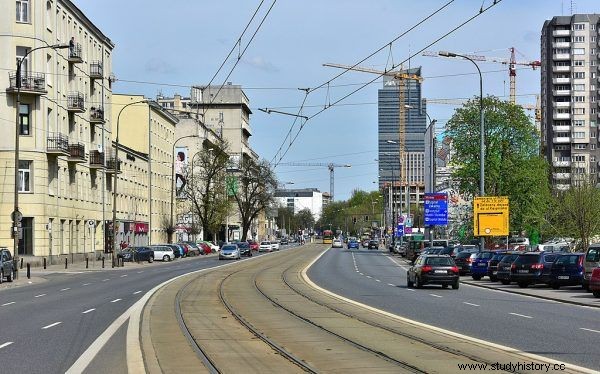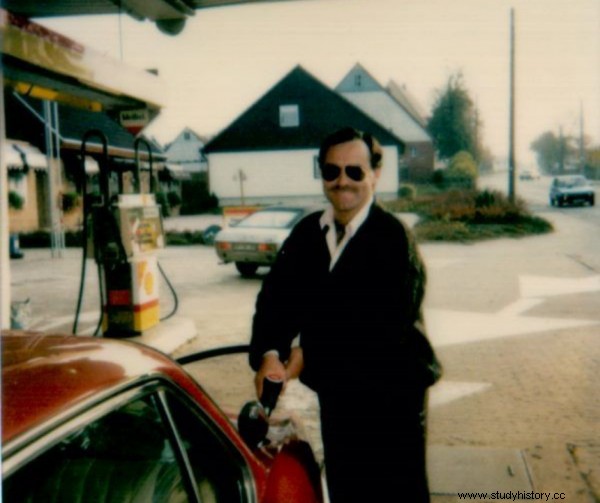The colorful life of Polish gangsters often ended at the least expected moment. And not in a natural way. The most famous cases of mafia executions are still surrounded by many secrets, and the prosecution's investigations have long stalled. Is there a chance that we will know the whole truth one day?
Many mobsters dreamed of deserving the title of "king of the mafia" and devoted their entire lives to this goal. This was the case, for example, in the case of Nikodem Skotarczak, the famous "Nikos" from the Tri-City. He made it. "Deservedly or undeservedly, the title was awarded to" Nikosia "in the Third Republic of Poland by the press and television" - writes his biographer Tadeusz Batyr in the book "Confession of Nikosia from the grave" .
The famous citizen of Gdańsk, like many other bosses, however, paid for his imperious ambitions with his life. What do we know about the bloodiest executions in the first decade of the Third Polish Republic?
5. "Pershing"
Hiding under the pseudonym "Pershing", Andrzej Kolikowski was one of the most important figures in the Polish criminal world of the 1990s. Although he started his activity in the previous decade, it was then that he became the leader of the most famous mafia of the Third Polish Republic - the Pruszków gang. He led it, but only informally, because "officially" the power belonged to the collective management.

The ski capital of Poland at the end of the 90s became the site of one of the most famous Mafia executions.
His career, however, was abruptly cut short in early December 1999. Pershing has just gone skiing in Zakopane. On the afternoon of December 5, he had just finished a series of descents and headed for the car left in front of the hotel. As he was packing his gear in the trunk, two camouflaged men emerged from a nearby car. They drew their weapons and, as they approached their victim, they began firing. They fired the first series into the air, but after a while one of them aimed at the boss of Pruszków . This one didn't have a chance to survive.
After that, the bombers hurried away, leaving Pershing in a puddle of blood in the snow. The road blockade ordered in the vicinity of Zakopane did not help - the perpetrators could not be stopped. Only after some time the prosecutor's office indicated possible guilty parties. They were two gangsters known to the police - Ryszard Bogucki and Ryszard Niemczyk. According to the investigators, the executioner of Kolikowski was the former.
How was it really? It is not known to this day. Among other things, the role of the young girl who accompanied Pershing on the trip is unexplained. At the time of the attack, she was returning the skis to the rental shop. She found herself in suspicion when it was discovered that she had destroyed the SIM card on her companion's phone shortly after the murder.
One thing is for sure. The list of enemies who cared about the death of the boss Pruszkow is very long. It includes both members of rival groups and enemies within the mafia ...
4. Zbigniew Nawrot
The influence of the Polish mafia often reached beyond the country's borders. This was the case with the gangster Zbigniew Nawrot. He fled Poland as early as 1979, and in the early 1990s he settled in Hamburg, Germany. There, he produced, among others, Royal brand spirit, which was later sold on the Polish market.
However, building the position of the king of spirits by an enterprising gangster was quickly and spectacularly interrupted. On November 1, 1991, in Hamburg, Nawrot was getting into his impressive Ferrari Testarossa when a bomb hidden under the car exploded. It was both luxurious and severely injured the driver. The man died in the hospital.
The force of the blast was so powerful that, apart from the actual victim, also two bystanders were killed. The woman accompanying the gangster was also seriously injured. Traces of the explosion were visible at a considerable distance from the scene.

A powerful explosion tore the luxury car of the mobster - Ferrari Testarossa. Illustrative illustration.
The perpetrator of the attack turned out to be a minor criminal, Jerzy B. He did not act on his own. The police recognized Mieczysław M., a mafioso from Bielsko-Biała, as his principal. He was arrested. However, many doubt the correctness of this version. Especially since Nawrot has had suspicious relationships with many underworld figures, including Marian K., also known as Ricardo Fanchini. This Silesian criminal, who has contacts with the Russian mafia, is widely regarded as the most famous Polish gangster operating abroad. So maybe there is more to discover in the mystery of Relapsed's death than we think?
3. "Postek" and "Maks"
The era of the Polish mafia did not end with the end of the heyday of Pruszków. Influential criminal groups also functioned in the first decade of this century. One of them was the so-called Mokotów group, which largely took over from its predecessors from Warsaw.
It is the people of Mokotów that are responsible for the cruel murder of two small drug dealers in the service of the so-called "mutant gang":Jacek P. "Postek" and Tomasz M. "Maks". The victims, caught in a trap at the beginning of the new millennium, were buried in a hole in the thickets of the Chojnów Landscape Park, near the road connecting Konstancin with Góra Kalwaria. It was only years later, in 2014, that their decomposed bodies were found.

The bodies of "Postek" and "Maks" were found in the Chojnów Landscape Park.
This crime has gone down in history because of the ruthless brutality of the perpetrators. Before their death, Postek and Maks were handcuffed and brought to the execution site in the trunk. Before their deaths, they were tortured for a long time by their torturers. The rumor circulating in the community even said that one of the victims was buried in a grave while still alive ...
Wojciech S. "Wojtas", also known as the "Manager", associated with the Mokotów mafia, was responsible for the murder of two young dealers. What was the reason for the cruel murder? It turned out to be another, extremely brutal installment of the gang war near Warsaw.
2. Shootout in Gama
One of the most famous mafia executions in the history of Poland was carried out in the Gama restaurant in Warsaw. A rebellious member of the Wołomin group was responsible for it - Karol S. His victims were, among others, his two former superiors - Ludwik Adamski "Lutek" and Marian Klepacki "Maniek" (also known as "Stary Klepak").

Lutek and Maniek were shot in the Gama restaurant on Wolska Street in Warsaw.
Lutek and Maniek were an expressive and quite harmonious duo of mafia bosses. The former was responsible for logistics and planning, the latter for power solutions. According to the crown witness of "Masa", already in the times of the People's Republic of Poland, when he was serving his sentence, he became famous for his daring beatings of prison service employees.
On March 31, 1999, on a sunny, spring afternoon, both gangsters went to the Gama restaurant in Warsaw's Wola district. Just before 1 p.m., three armed and masked men approached their table. They executed them with a violent series of shots. Then they escaped to a polonaise parked in front of the entrance and set off into the unknown. Not only Lutek and Maniek died in the incident, but also three other people of Wołomin who were accompanying them.
The shooting in Gama went down in the history of Polish organized crime. Nothing unusual. Five massacred bodies lying in the water flowing from the radiators pierced by bullets - this is a sight straight from a sensational film. Meanwhile, this was the reality of Warsaw at the end of the 1990s ...
1. "Nobody"
To this day, the death of "the mafia king", "Nikos", is also unexplained. Nikodem Skotarczak was one of the most expressive figures of the Polish underworld. He started his "career" in the 1970s, acting in a gang of car thieves. Later he moved to Germany to return to his hometown Tri-City in the early 1990s.
Nikos was famous for his love of show business. He had connections in the world of stars, even played an episode in the movie "Sztos" . In the 1980s, he was also a successful sponsor of the Lechia Gdańsk football club.
For many years he was pursued by the police. He had slipped out of her hands many times. Perhaps the most daring was his escape from the Berlin prison. As Tadeusz Batyr writes in the book "Nikosia's confession from behind the grave" :
(...) escaped with genuine fantasy and cinematic bravado. During the visit of his brother Marek Skotarczak, on December 4, 1989, he changed clothes and roles with him. After the visit, Marek Skotarczak went to Nikosia's cell, while he himself (...) left the walls of Tegel.

The mystery of the death of "Nikos", one of the most recognizable Polish gangsters of the 1990s, remains unsolved to this day. Photo from the book "Nikos' confession from beyond the grave".
Unfortunately, the fantasy was useless when Skotarczak was also sentenced to death. He died on April 24, 1998. At that time, he was staying at the Gdynia escort agency "Las Vegas". Suddenly, two masked men entered the club. They found the room in which the Tri-City gangster was located and shot him in the head at close range, killing him on the spot.
The murderers were not caught, and the murder of Nikos is still one big question mark. The hypothesis about the involvement of gangsters from Pruszków in the crime is probable. Skotarczak was at odds with some of them. Other leads lead to local Gdańsk mafiosi, such as Daniel Z. "Zachar", as well as to the management of the Łódź-based "Ośmiornica". They could all be anxious for the death of the mafia king for various reasons. In which of these centers was the decision to eliminate it taken? We may never know.
